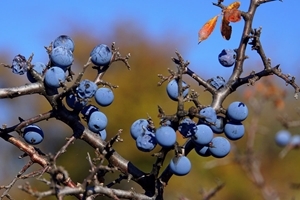Blackthorn
 The seasons have felt quite odd this year. It started with a seemingly late spring, followed by a start-stop harvest, but now it is finally starting to feel a bit chilly. The change in season was very much felt last Saturday (23 October) while I was at Rotherfield Park Estate with my colleagues representing the GWCT on our stand at the National Hedgelaying Championships. It was a fantastic day speaking to the visitors, who were interested in what part hedgerows play in the landscape, and give advice on best practice. It was an easy sell really – hedges provide food sources, nesting sites, foraging habitats and are wildlife corridors for a huge variety of insects, birds and mammals. They also help prevent soil erosion, give shelter for livestock and sequester carbon. What's not to like!
The seasons have felt quite odd this year. It started with a seemingly late spring, followed by a start-stop harvest, but now it is finally starting to feel a bit chilly. The change in season was very much felt last Saturday (23 October) while I was at Rotherfield Park Estate with my colleagues representing the GWCT on our stand at the National Hedgelaying Championships. It was a fantastic day speaking to the visitors, who were interested in what part hedgerows play in the landscape, and give advice on best practice. It was an easy sell really – hedges provide food sources, nesting sites, foraging habitats and are wildlife corridors for a huge variety of insects, birds and mammals. They also help prevent soil erosion, give shelter for livestock and sequester carbon. What's not to like!
The event made me remember the many years of hedgelaying I have done and the satisfaction it gave me when I stood back and looked at the metres woven down, knowing this would increase the life of the hedge and boost its ecological value by promoting new regrowth at the base, which provides cover for a greater number of species, especially for the iconic grey partridge where we were that day.
But it also reminded me of a time when I used to be covered in scratches for months from the quite vicious blackthorn (Prunus spinosa). So, with that in mind, blackthorn is this Species of the Month. Blackthorn is a thorny shrub that can cause nasty wounds if left untreated and has a lot of dark folklore and legends attached, but is fantastic in many other ways too…
Folklore has it, blackthorn is esoterically known as both the Mother of the Woods and the Dark Crone of the Woods and is depicted in many fairy tales throughout Europe as a tree of ill omen. Called 'straif' in the Ogham (an early Medieval alphabet used primarily to write the early Irish language), this tree has the most sinister reputation in Celtic tree lore, where it is thought the English word 'strife' has derived from.
However, early to blossom, it provides a vitally important early source of nectar for insects from its snow-white flowers. Blackthorn is monoecious, meaning both male and female reproductive organs are found in one flower, and when in full bloom the hedges resemble white clouds, laying low in in the linear landscape. They are a densely branched thorny shrubs with smooth, dark brown bark, and a mature tree can grow to a height of around 7 metres and live up to 100 years if managed correctly!
They’re best known for their rich, inky, dark fruits used to make one of my favourite wintry tipples – sloe gin. Sloes are the fruit of the blackthorn, which are ripening now and turn a dusty blue colour – but remember to pop them in the freezer if you pick them before the first frost. Here’s a fun fact: the dust is actually a yeast bloom that forms over the fruit and is thought to enhance UV light reflection so that the fruits really stand out to birds, which have UV vision. A brilliant, evolved strategy to attract the agents that disperse its seed far and wide, as passing birds will spot the fruit shining out in the wintery hedgerow like baubles and flock down to feed on them, especially the migrants that are coming in now like the redwings and fieldfares, which will gorge on the sloes and disperse the seeds as they go – the sloe-motion!
"Of all the trees that grow so fair, Old England to adorn, Greater are none beneath the Sun Than Oak and Ash and Thorn." - Rudyard Kipling, Puck of Pook’s Hill (1906)
Megan Lock
Advisory
Photo credit: Peter Langereis